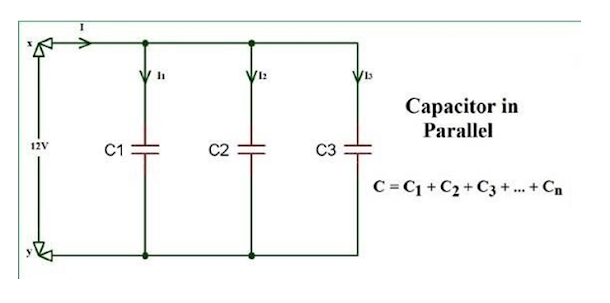Unit 10 : Capacitor in circuit
Capacitors (originally called electrical condensers) are analog electrical components that can collect and store electrical energy not electrical charge.
Capacitor can store energy quickly and can release energy quickly.
As a direct current flows into a capacitor, it charges with energy and releases an alternating current flow back into the circuit.Most capacitors have a positive and negative terminal.
Working principle
of capacitor:
let us consider a parallel plate capacitor with a dielectric between
them as shown in the below circuit.
Now, apply the voltage V as shown
in the circuit, plate 1 has the positive charge and plate 2 has negative charge.
Across the capacitor an electric field appears. When these plates are applied with the voltage
they will carry positive charge from the battery at plate 1 and negative charge on plate 2. For some time
the voltage is applied and within that time the capacitor
gets charged to the maximum
limit of holding
charge and this time is called as charging time of the capacitor.
After some time when the capacitor has
reached its maximum limit of charging then we will cut the supply of power
to the capacitor. For a certain time,
the two plates
hold a negative and positive
charge. Thus, the capacitor acts as a source or
electric charge
Capacitor in
Series:
Series capacitors are more effective
on distribution circuits
with higher X/R ratio and for load variations involving
a higher reactive content.
Capacitors connected in series. The magnitude of
the charge on each plate is Q, C is capacitor
and V is Voltage.
Series connections produce a total
capacitance that is less than that of any
of the individual capacitors. It is a general feature
of series connections of
capacitors that the total capacitance is less than any of the individual capacitances.
We can find an expression for the total capacitance by considering the voltage across the individual capacitors shown in Figure.
Q= CV …. (Chage from capacitor C and Voltage V )
V
Now, calling the total capacitance CS for series capacitance, consider that
C
Entering the expressions for V1, V2, and V3,
we get
![]()
![]()
![]()
![]() Q= Q + Q + Q
Q= Q + Q + Q
![]() C C1 C2 C3
C C1 C2 C3
Canceling the Qs,
we obtain the equation for the total capacitance in series C to
be
C C1 C2 C3
Total Capacitance in Series, Cs
![]()
![]()
![]()
![]() Total capacitance in series: 1= 1 + 1 + 1
Total capacitance in series: 1= 1 + 1 + 1
C C1 C2 C3
Capacitors in Parallel
Capacitors in parallel refer to the capacitors that are connected together in parallel when the connection of both of its terminals takes place to each terminal of another capacitor.
When capacitors are connected
together in parallel the total or equivalent
capacitance, CT in the circuit is equal to the sum of all the individual capacitors added together. This is because the top plate of capacitor, C1 is connected to the top plate of C2 which is connected to the top plate of C3 and so on.
Using the relationship Q=CV, we see that the total charge is Q=CV
and the individual charges
are Q1=C1V, Q2=C2V, and Q3=C3V. Entering
these into the previous equation
gives
CV = C1 V + C2 V + C3V
Canceling V from the equation, we obtain the equation for the total capacitance in parallel
C = C1 + C2 + C3

Prepared by :Mausham aryal





